Introduction
Expanding public health knowledge, with a preference for natural ingredients and colorants, has led to an increase in consumption of functional health-promoting foods.1 A balanced and healthy nutritional diet contains vitamins, minerals, and polyunsaturated fatty acids (PUFAs).2 Microalgae are a rich natural source of bioactive compounds for a healthy diet. They contain proteins, carbohydrates, lipids, minerals, vitamins, essential amino acids, PUFAs, carotenoids, enzymes, and fiber.3 The microalga Arthrospira or Spirulina is produced commercially all over the world and has been used in human food for thousands of years.4 Arthrospira is a micro-filamentous cyanobacterium with generally recognized as safe (GRAS) status as a functional food by the US Food and Drug Administration.5 Previous data relating to the safety and side effects of Arthrospira were mainly concerned about human clinical potential and application.6 Arthrospira has potential health benefits including carbohydrate, protein, essential amino acids, essential fatty acids, minerals, vitamins, and pigments.7 Moreover, the lack of cellulosic cell walls allows easy digestion of Arthrospira biomass as suitable and acceptable for human consumption.8
Fermented milk products or yogurt are preferred foods for probiotics9 as live microorganisms of bacteria or yeast that provide their host with health benefits.10 They promote gastrointestinal health benefits through various intestinal functions and electrolyte balance, nutrient absorption, transit time, and management of digestive issues. Probiotics improve nutrient digestibility and metabolic utilization by generating volatile fatty acids that indirectly modify gut microsystems.11,12 Lactobacillus and Bifidobacterium are the main genera used in probiotic products.10
Market trends for natural sources in food and beverages indicate the potential of utilizing microalgae to satisfy demand. Various species of microalga including Arthrospira, Chlorella, Dunaliella, and Haematococcus have been developed and incorporated in food products.4 Arthrospira farms produce food supplements but studies are lacking in food product ingredients. Yogurt is a commercially popular fermented food in Asian regions and has potential for supplementation as an alternative natural source of functional food. Therefore, the main objective of this study was to supplement yogurt with Arthrospira microalgae rich in bioactive compounds as healthy food. Nutrient composition, functional and physicochemical properties, and significant parameters of Arthrospira supplemented yogurt products were evaluated during 4 weeks of storage.
Materials and Methods
Arthrospira Preparation
Arthrospira (Spirulina) platensis IFRPD 1182 was provided by the Institute of Food Research and Product Development (IFRPD), Kasetsart University, Bangkok, Thailand and maintained in Zarrouk medium. The condition of A. platensis cultivation followed Pan-utai et al.,13 Arthrospira was cultured in a glass photobioreactor which was incubated in chamber equipment with temperature controlled at 30°C, light intensity at 15 Klux and light and dark cycles at 16 and 8 hours respectively. Carbon dioxide mixed with air at 2% was used as a continuous bubble feed with flow rate at 0.67 vvm. Cells were grown to log phase and used as inoculum at 10% in an open raceway pond system containing 200 liters of working volume. The culture was well mixed using a paddle wheel at 15 rpm. Cells were grown to exponential phase around 1 at an optical density of 560 nm, harvested by filtration through a nylon cloth and washed with tap water to completely remove residual culture medium. Fresh Arthrospira biomass was mixed with sterilized water at a ratio of 1:1 (w/w) using homogenization at 11,000 rpm for 3 min (Ultra Turrax, T25 basic, IKA, USA) and filtered through 0.45 µm nylon membrane to remove residual cells. Dried Arthrospira biomass was obtained by drying at 55 °C for 6 hours or until less than 5% moisture content. Dried biomass samples were then milled to 0.5 mm particle size for use in yogurt as supplemented dried Arthrospira biomass.
Yogurt Production
Yogurt preparation was based on pasteurized fresh cow’s milk (CP-Meiji Co., Ltd., Thailand) as raw material. The milk formulation was composed of sugar at 7% (w/v) and gelatin as thickener at 0.5% (w/v). Arthrospira microalgal were supplemented with oven-dried Arthrospira biomass at 0.1, 0.3, and 0.5% (w/v) and fresh Arthrospira at 1, 5, and 10% (v/v). Fresh Arthrospira content was examined on a dry weight basis and expressed as around 6.9% DW. Thus, concentrations of fresh Arthrospira supplemented into yogurt at 1, 5 and 10% (v/v) in terms of dry basis were expressed as 0.07, 0.35, and 0.69% (w/v), respectively. Milk formulation without Arthrospira supplement was used as the control. Milk formulations were heated for 20 min at 85°C and then cooled to 40°C. A commercial starter culture YC-X11 (Lactobacillus delbrueckii subsp. bulgaricus and Streptococcus thermophilus) was mixed according to the manufacturer’s instructions (Chr. Hansen, Denmark) and added to the samples. After mixing well and transferring into plastic cups, all samples were incubated at 43°C for 4 hours. The pH and acidity were determined every hour during fermentation. After fermentation, the yogurt samples were cooled and kept at 4°C. All samples were analyzed for pH, titratable acidity, water holding capacity, nutritional composition, C-phycocyanin content, and color after fermentation. In addition, pH, titratable acidity, and color were analyzed during storage at 1, 2, 3, and 4 weeks.
Physicochemical Measurement
All samples were determined for pH and acidity during yogurt fermentation and storage. The pH was measured using a pH meter (Schott, Lab850, Germany). The percentage of titratable acidity (TA) of the yogurt samples was analyzed using 0.1 N NaOH solution using phenolphthalein as the indicator.14 Acidity was calculated as a percentage of lactic acid produced. The factor is 90.08 (g/mol) which is the molecular weight of lactate. The pH and acidity were measured at different stages of sample preparation including during fermentation, finished products and during storage.
Water holding capacity (WHC) of the different yogurt samples was determined according to the method of Barkallah et al.,15 WHC was analyzed by centrifuging 10 g of each sample at 4,500 x g for 20 min at 4°C (Sorvall RC6 Plus, Thermo Scientific, Germany) and calculated according to the following equation:
WHC (%) = (1-W1/W2) x 100
where W1 is the weight of supernatant after centrifugation and W2 is the weight of yogurt.
Nutritional Composition
Proximate composition of the yogurt samples was analyzed using the AOAC standard method.16 Dry weights of the samples were analyzed by oven-drying at 105°C overnight to constant weight. Ash content was determined by ignition of the dried samples in an electric furnace at 550°C. Protein content was analyzed by the Kjeldahl method using a nitrogen conversion factor of 6.25. Total lipid contents of the yogurt samples were determined using the ether extraction method (AOAC Official Method 989.05). Carbohydrate content was calculated by difference as the sum of moisture, protein, lipid, and ash content in 100 g dry weight.
C-phycocyanin Content
For determination of C-phycocyanin content, 1 ml of each samples was centrifuged at 5,000 rpm for 10 min. The pellet was dissolved and then sonicated in 1 ml of distilled water for 30 min. The supernatant was collected by centrifugation at 10,000 rpm for 5 min and measured for optical density at 615 and 652 nm (SP-80001, UV/vis Spectrophotometer, Metertech, Taiwan). C-phycocyanin content was calculated using the following equation.17
C-phycocyanin (mg/mL) = (OD615-0.474OD652)/5.34
Color Evaluation
Color parameters were determined using a Datacolor Spectraflash Spectrophotometer (SF 600 plus, Datacolor International, USA). The instrument was standardized using a standard black trap and white and green plates. Color measurements were expressed in terms of 3 values: lightness (L*) from 0 (black) to 100 (white) with chromaticity parameters, a* as green color (-) to red (+) and b* as blue (-) to yellow (+).
Statistical Analysis
All experiments were analyzed in triplicate. Data from the parameters were subjected to analysis of variance (ANOVA) using SPSS 12.0 (SPSS, Inc., USA). Multiple comparisons in each parameter were conducted using Duncan’s multiple range test (DMRT) with significance set at 0.05 (P˂0.05).
Results and Discussion
Arthrospira platensis microalga was used as the ingredient supplemented in yogurt and investigated as a functional food. All parameters including physicochemical composition, nutritional composition, C-phycocyanin content, and color index value changes during fermentation were determined. Changes in pH, acidity, and color indexes of yogurt products were also assessed during 4 weeks of storage. Yogurt without Arthrospira supplementation was used as the control.
Physicochemical Measurement
Arthrospira platensis was prepared as oven-dried biomass and fresh biomass for supplementation in yogurt. The pH values during yogurt fermentation for 4 hours at 43°C and storage at 4°C for 4 weeks are shown in Table 1. The pH values decreased with increasing time during the fermentation process in all experiments. Initial pH values of different conditions were approximated at 6 and decreased to around 4 after 4 hours of fermentation, whereas pH did not fluctuate under storage for 4 weeks. Milk fermentation was inoculated from thermophilic bacteria consisting of a mixture of Lactobacillus delbrueckii and Streptococcus thermophilus as gelation form. Milk formulation involved heating at high temperature. This caused the denaturation of whey proteins. Gelation, as caseins reach their isoelectric point, results in denatured whey proteins interacting with casein on the surface of casein micelles from around pH 6.6 to 4.6 during yogurt fermentation.18 Moreover, variations in fermentation time were due to differences in the ability of lactic acid bacteria to grow and ferment in milk.19 The pH values among various sample treatments were slightly lower than the control during 2-4 hours of fermentation. Similar results from previous reports of A. platensis addition in fermented milk showed larger decrease in pH.20 High protein content of Arthrospira microalgae promoted the growth of probiotics in milk.21 Therefore, both oven-dried and fresh Arthrospira supplemented in yogurt gave pH values lower than the control and supported the growth of lactic acid bacteria. Valuable proteins and carbohydrates from Arthrospira increased nitrogen and carbon sources in milk formulation, and also increased solid content that supported growth of probiotics during fermentation. These properties were attributed to different yogurt buffering capacities. Yogurt supplemented with Arthrospira presented lower buffering capacity during fermentation. Moreover, increase in Arthrospira supported growth rates and viability of lactic acid bacteria.10
Table 1: The pH values during yogurt fermentation for 4 hours at 43 °C and 4 weeks of storage at 4 °C.
| Time | Control | Oven-dried Arthrospira (%w/v) | Fresh Arthrospira (%v/v) | ||||
| 0.1 | 0.3 | 0.5 | 1 | 5 | 10 | ||
| Fermentation (h) | |||||||
| 0 | 6.18 ± 0.00 abcA | 6.17 ± 0.01 bcA | 6.21 ± 0.02 aA | 6.20 ± 0.01 abA | 6.17 ± 0.00 bcA | 6.17 ± 0.00 bcA | 6.16 ± 0.01 cA |
| 1 | 5.97 ± 0.01 aB | 5.96 ± 0.00 aB | 5.95 ± 0.02 abB | 5.92 ± 0.01 bB | 5.72 ± 0.02 eB | 5.84 ± 0.02 cB | 5.79 ± 0.01 dB |
| 2 | 5.35 ± 0.04 aC | 5.31 ± 0.02 aC | 5.20 ± 0.01 bC | 5.19 ± 0.02 bC | 5.09 ± 0.06 cC | 5.18 ± 0.01 bC | 5.10 ± 0.02 cC |
| 3 | 4.75 ± 0.02 aD | 4.67 ± 0.06 bcD | 4.70 ± 0.01 abD | 4.71 ± 0.03 abD | 4.60 ± 0.01 dD | 4.66 ± 0.03 bcdD | 4.61 ± 0.02 cdD |
| 4 | 4.39 ± 0.01 aE | 4.28 ± 0.02 cE | 4.18 ± 0.01 eE | 4.21 ± 0.00 dE | 4.37 ± 0.01 aE | 4.32 ± 0.02 bE | 4.31 ± 0.00 bE |
| Storage (weeks) | |||||||
| 1 | 4.13 ± 0.01 abcF | 4.08 ± 0.00 bcF | 4.06 ± 0.01 cF | 4.11 ± 0.02 abcF | 4.15 ± 0.03 abF | 4.19 ± 0.07 aF | 4.11 ± 0.05 abcF |
| 2 | 4.08 ± 0.02 aG | 4.00 ± 0.00 bG | 3.99 ± 0.01 bG | 4.06 ± 0.00 aF | 4.08 ± 0.02 aG | 4.00 ± 0.03 bH | 3.96 ± 0.02 bH |
| 3 | 4.08 ± 0.02 abG | 3.93 ± 0.03 dG | 4.04 ± 0.04abcFG | 4.01 ± 0.02 cG | 4.09 ± 0.04 aFG | 4.10 ± 0.02 aG | 4.02 ± 0.00 bcG |
| 4 | 4.13 ± 0.00 aF | 4.00 ± 0.01 bG | 4.01 ± 0.05 bFG | 4.01 ± 0.04 bG | 4.09 ± 0.01 aFG | 4.13 ± 0.02 aFG | 4.08 ± 0.00 aF |
Values are averages of triplicates ± standard deviation. Mean values with different superscript letters indicate significant differences.
a, b,… Means in the same row with different letters are significantly different (P<0.05).
A, B,… Means in the same column with different letters are significantly different (P<0.05).
Table 2: Titratable acidity (%) during yogurt fermentation for 4 hours at 43°C and 4 weeks of storage at 4°C.
| Time | Control | Oven-dried Arthrospira (%w/v) | Fresh Arthrospira (%v/v) | ||||
| 0.1 | 0.3 | 0.5 | 1 | 5 | 10 | ||
| Fermentation (h) | |||||||
| 0 | 0.19 ± 0.04 aF | 0.17 ± 0.01 aF | 0.19 ± 0.01 aE | 0.20 ± 0.00 aE | 0.18 ± 0.00 aF | 0.17 ± 0.01 aG | 0.17 ± 0.01 aH |
| 1 | 0.19 ± 0.01 cF | 0.20 ± 0.00 cF | 0.23 ± 0.01 abE | 0.24 ± 0.01 aE | 0.21 ± 0.01 bcF | 0.20 ± 0.00 cG | 0.21 ± 0.00 bcG |
| 2 | 0.30 ± 0.01 bE | 0.30 ± 0.00 bE | 0.36 ± 0.02 aD | 0.39 ± 0.01 aD | 0.41 ± 0.04 aE | 0.36 ± 0.03 aF | 0.37 ± 0.01 aF |
| 3 | 0.50 ± 0.00 bcD | 0.51 ± 0.01 bcD | 0.56 ± 0.02 aC | 0.59 ± 0.02 aC | 0.46 ± 0.02 cD | 0.51 ± 0.04 bE | 0.49 ± 0.00 bcE |
| 4 | 0.55 ± 0.01 eC | 0.65 ± 0.00 cC | 0.76 ± 0.02 bB | 0.78 ± 0.01 aB | 0.61 ± 0.01 dC | 0.61 ± 0.01 dD | 0.61 ± 0.01 dD |
| Storage (weeks) | |||||||
| 1 | 0.70 ± 0.03 cdB | 0.75 ± 0.01 bB | 0.84 ± 0.01 aA | 0.86 ± 0.01 aA | 0.72 ± 0.00 bcB | 0.68 ± 0.01 dC | 0.68 ± 0.00 dC |
| 2 | 0.81 ± 0.03 abcA | 0.83 ± 0.03 abcA | 0.87 ± 0.01 abA | 0.90 ± 0.08 aA | 0.78 ± 0.01 cA | 0.82 ± 0.01 bcA | 0.80 ± 0.01 bcA |
| 3 | 0.74 ± 0.03 cB | 0.80 ± 0.01 bA | 0.84 ± 0.03 abA | 0.86 ± 0.01 aA | 0.74 ± 0.01 cAB | 0.73 ± 0.02 cB | 0.74 ± 0.00 cB |
| 4 | 0.73 ± 0.00 cB | 0.81 ± 0.02 bA | 0.87 ± 0.01 aA | 0.90 ± 0.02 aA | 0.76 ± 0.00 cA | 0.72 ± 0.00 cB | 0.72 ± 0.04 cB |
Values are averages of triplicates ± standard deviation. Mean values with different superscript letters indicate significant differences.
a, b,… Means in the same row with different letters are significantly different (P<0.05).
Titratable acidity values during yogurt fermentation and storage are shown in Table 2. Increased acidity of yogurt during fermentation was observed in all experiments. Arthrospira addition increased acidity faster than the control and was related to the higher buffering capacity of media containing Arthrospira.10 The finished yogurt product supplemented with 0.5% oven-dried Arthrospira gave the highest acidity of 0.78%. Acidity of finished products with oven-dried Arthrospira supplemented in yogurt increased at higher concentrations of oven-dried Arthrospira, whereas fresh Arthrospira showed no significant differences with concentration. The control showed the lowest acidity. Moreover, results also indicated that pH decreased and titratable acidity increased during yogurt fermentation with thermophilic bacteria over 4 hours. Lactic acid production from lactose fermentation led to decreasing pH and increasing titratable acidity as a result of microorganism metabolism.22 Titratable acidity also slightly increased during the first week of storage due to the decrease in temperature from fermentation to storage. As mentioned, lactic acid fermentation continuing growth and produced lactic acid from active cell viability until becoming stable at storage temperature. Lactic acid bacteria (LAB) instigate three significant biochemical conversions of milk constituents consisting of carbohydrate to lactic acid or other metabolite substances, casein hydrolysis to peptides and breakdown of free amino acids and milk fat to free fatty acids. The role in milk fermentation by lactic acid bacteria produces the final product as lactic acid. Moreover, organic acids provide the flavor and aroma of yogurt as well as acting as a preservative.22,23
Water holding capacity in fermented milk like yogurt is mainly determined by the microstructure of the protein network. Water holding capacity indicates the ability of proteins to prevent water releases from their three-dimensional structure. Furthermore, whey protein is vented on the surface of the product if the water-binding capacity is not sufficient.24 Results showed that water holding capacity in all experiments ranged at 53-62% (Figure 1). Fresh Arthrospira supplemented in yogurt displayed the highest water holding capacity. However, the values of water holding capacity showed little difference among various conditions. Yogurt products supplemented with Arthrospira showed the ability to retain water after fermentation.
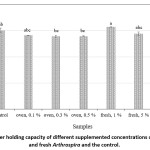 |
Figure 1: Water holding capacity of different supplemented concentrations of oven-dried and fresh Arthrospira and the control. Click here to View figure |
Nutritional Composition
Nutritional compositions of yogurt supplemented with various concentrations of oven-dried and fresh Arthrospira and the control treatment as moisture content, protein, fat, ash, and carbohydrate are shown in Table 3. All treatments had similar nutritional compositions compared to the control. Although Arthrospira has high protein content, yogurt products cannot be added with large amounts of oven-dried Arthrospira powder because this imparts an unsuitable flavor. Previous experiments showed that all organoleptic properties of yogurt with high microalgal powder concentration at 0.75 and 1% gave lower sensory acceptability scores. Unacceptable flavor at higher Arthrospira powder concentration results from the oxidation of lipids and minerals that act as pro-oxidant molecules and produce metallic off-flavors.25
Arthrospira platensis is considered as a food source of natural molecules with functional composition and nutritional health benefits.26 Arthrospira is a dried food, easy to store and transport with long shelf life.27 Moreover, oven drying of Arthrospira is a conventional low-cost process that also affects protein denaturation in cell structure and composition.13 However, fresh Arthrospira biomass has higher nutritional value compared with the dried biomass. Oven-dried Arthrospira biomass showed reduced protein content of 35% with respect to the fresh biomass.28 Therefore, fresh Arthrospira supplemented into yogurt treatments gave similar nutritional composition with oven-dried Arthrospira. Yogurt products supplemented with fresh Arthrospira produced an off-flavor and smell compared with oven-dried biomass. Furthermore, Arthrospira has high iron content. Iron bio-availability has been trialed in both rats and humans without side effects. Thus, yogurt supplemented with Arthrospira has proven nutritional beneficial iron content enrichment.29
Table 3: Nutritional composition of control, oven-dried, and fresh Arthrospira supplemented in yogurt after production.
| Composition | Control | Oven-dried Arthrospira (%w/v) | Fresh Arthrospira (%v/v) | ||||
| (g/100 g dry weight) | 0.1 | 0.3 | 0.5 | 1 | 5 | 10 | |
| Moisture | 81.57 ± 0.04 | 82.11 ± 0.57 | 82.22 ± 1.14 | 81.20 ± 0.24 | 81.84 ± 0.07 | 82.53 ± 0.03 | 83.24 ± 0.01 |
| Protein | 18.43 ± 0.04 | 17.89 ± 0.57 | 17.78 ± 0.14 | 18.80 ± 0.24 | 18.16 ± 0.07 | 17.47 ± 0.03 | 16.76 ± 0.01 |
| Fat | 15.54 ± 0.76 | 17.14 ± 1.54 | 17.47 ± 1.21 | 18.65 ± 0.20 | 16.91 ± 0.42 | 16.79 ± 0.06 | 16.08 ± 0.09 |
| Ash | 5.02 ± 0.53 | 3.61 ± 0.07 | 4.53 ± 0.54 | 4.59 ± 0.60 | 3.62 ± 0.11 | 4.00 ± 0.86 | 3.80 ± 0.68 |
| Carbohydrate | 0.66 ± 0.01 | 0.63 ± 0.04 | 0.66 ± 0.01 | 0.68 ± 0.02 | 0.67 ± 0.00 | 0.63 ± 0.01 | 0.60 ± 0.01 |
Color Evaluation
Yogurt with Arthrospira supplemented treatments achieved different colors of final product as shown in Figures 2-4. Color shade of yogurt supplemented with Arthrospira changed from green to blue depending on the added concentration. The color of dairy products is important for consumer acceptance.30 Values of L*, a*, and b* indexes recorded lightness, green to red, and blue to yellow respectively. All treatments showed negligible variations after storage for 4 weeks. Yogurt with fresh Arthrospira samples showed increased whiteness when compared with oven-dried biomass supplementation, whereas higher quantity of oven-dried biomass gave more greenness than fresh Arthrospira supplement. Moreover, yogurt samples with fresh Arthrospira had higher blue color indexes as fresh Arthrospira gave more C-phycocyanin.
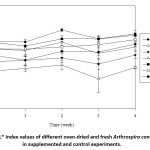 |
Figure 2: The L* index values of different oven-dried and fresh Arthrospira concentrations in supplemented and control experiments. Click here to View figure |
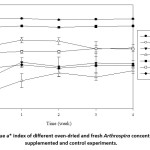 |
Figure 3: Value a* index of different oven-dried and fresh Arthrospira concentrations in supplemented and control experiments. Click here to View figure |
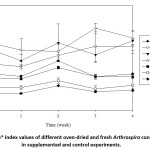 |
Figure 4: The b* index values of different oven-dried and fresh Arthrospira concentrations in supplemented and control experiments. Click here to View figure |
C-phycocyanin Content
Arthrospira, a blue-green alga that contains blue pigment as C-phycocyanin (C-PC), is mostly consumed as a natural edible and functional brilliant blue colorant. The alga has excellent antioxidant, anticancer and anti-inflammatory properties. C-phycocyanin (C-PC) is found in cyanobacteria as a blue water-soluble light-harvesting protein-pigment complex.17 It is normally used as a food colorant ingredient and also as a pharmaceutical reagent with antioxidant and anti-inflammatory.31 Yogurt products were added with C-PC content under different treatments in the range 0.2-16.5 mg/g (Figure 5). All experiments showed that C-PC content increased with increasing Arthrospira addition. Oven-dried Arthrospira biomass gave lower C-PC content compared with fresh biomass caused by denaturation at high temperature. Higher C-PC content showed greater antioxidant activity. Our results concurred with Papalia et al.,28 who found that fresh Arthrospira gave higher antioxidant activity than frozen and oven-dried Arthrospira biomass. Yogurt supplemented with fresh Arthrospira achieved high nutritional and antioxidant activity as a functional product.
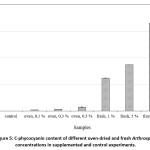 |
Figure 5: C-phycocyanin content of different oven-dried and fresh Arthrospira concentrations in supplemented and control experiments. Click here to View figure |
Conclusions
Arthrospira platensis has long been used as a food ingredient with important nutritional and functional properties. Milk fermented with Arthrospira addition can be used to develop new healthy yogurt products. Our results showed that yogurt supplemented with Arthrospira improved nutritional and functional properties, depending on type of preparation and concentration. It is difficult to assess the optimal condition for Arthrospira addition to yogurt. Fresh Arthrospira supplementation remains largely understudied; however, addition of fresh Arthrospira into yogurt improved nutritional and functional properties of the final product.
Acknowledgements
Thanks are due to the Institute of Food Research and Product Development (IFRPD), Kasetsart University for supplying the research instruments. Partial aspect of this research is protected by petty patent number 1903000763 under the Kasetsart University license.
Conflict of Interest
The authors declare no conflicts of interest.
References
- Vukasović T. Chapter 20 – Functional foods in line with young consumers: challenges in the marketplace in Slovenia. In: Bagchi D, Nair S, eds. Developing New Functional Food and Nutraceutical Products. San Diego: Academic Press; 2017:391-405.
- Sathasivam R, Radhakrishnan R, Hashem A, Abd_Allah EF. Microalgae metabolites: A rich source for food and medicine. Saudi Journal of Biological Sciences. 2019;26(4):709-722. DOI: 10.1016/j.sjbs.2017.11.003
- Barkia I, Saari N, Manning SR. Microalgae for high-value products towards human health and nutrition. Marine drugs. 2019;17(5):304. DOI: 10.3390/md17050304
- Koyande AK, Chew KW, Rambabu K, Tao Y, Chu D-T, Show P-L. Microalgae: A potential alternative to health supplementation for humans. Food Science and Human Wellness. 2019;8(1):16-24. DOI: 10.1016/j.fshw.2019.03.001
- Karkos PD, Leong SC, Karkos CD, Sivaji N, Assimakopoulos DA. Spirulina in clinical practice: evidence-based human applications. Evidence-based complementary and alternative medicine : eCAM. 2011;2011:531053-531053.
- Wan D, Wu Q, Kuča K. Chapter 42 – Spirulina. In: Gupta RC, ed. Boston: Academic Press; 2016:569-583.
- Kent M, Welladsen HM, Mangott A, Li Y. Nutritional evaluation of Australian microalgae as potential human health supplements. PLOS One. 2015;10(2):e0118985.
- Kose A, Ozen MO, Elibol M, Oncel SS. Investigation of in vitro digestibility of dietary microalga Chlorella vulgaris and cyanobacterium Spirulina platensis as a nutritional supplement. 3 Biotech. 2017;7(3):170-170. DOI: 10.1007/s13205-017-0832-4
- Patel P, Jethani H, Radha C, et al. Development of a carotenoid enriched probiotic yogurt from fresh biomass of Spirulina and its characterization. Journal of Food Science and Technology. 2019;56(8):3721-3731. DOI: 10.1007/s13197-019-03844-0
- Beheshtipour H, Mortazavian AM, Mohammadi R, Sohrabvandi S, Khosravi-Darani K. Supplementation of Spirulina platensis and Chlorella vulgaris Algae into Probiotic Fermented Milks. Comprehensive Reviews in Food Science and Food Safety. 2013;12(2):144-154. DOI: 10.1111/1541-4337.12004
- Vieco-Saiz N, Belguesmia Y, Raspoet R, et al. Benefits and inputs from lactic acid bacteria and their bacteriocins as alternatives to antibiotic growth promoters during food-animal production. Frontiers in Microbiology. 2019;10:57-57. DOI: 10.3389/fmicb.2019.00057
- Freitas M. Chapter 24 – The benefits of yogurt, cultures, and fermentation. In: Floch MH, Ringel Y, Allan Walker W, eds. The Microbiota in Gastrointestinal Pathophysiology. Boston: Academic Press; 2017:209-223.
- Pan-utai W, Kahapana W, Iamtham S. Extraction of C-phycocyanin from Arthrospira (Spirulina) and its thermal stability with citric acid. Journal of Applied Phycology. 2018;30(1):231-242. DOI: 10.1007/s10811-017-1155-x
- Dabija A, Codin GG, Ropciuc S, Gatlan A-M, Rusu L. Assessment of the antioxidant activity and quality attributes of yogurt enhanced with wild herbs extracts. Journal of Food Quality. 2018;2018:12. DOI: 10.1155/2018/5329386
- Barkallah M, Dammak M, Louati I, et al. Effect of Spirulina platensis fortification on physicochemical, textural, antioxidant and sensory properties of yogurt during fermentation and storage. 2017;84:323-330. DOI: 10.1016/j.lwt.2017.05.071
- (Association of Official Analytical Chemistry). Official methods of analysis of the Association of Analytical Chemists International. 2005.
- Pan-utai W, Iamtham S. Extraction, purification and antioxidant activity of phycobiliprotein from Arthrospira platensis. Process Biochemistry. 2019;82:189-198. DOI: 10.1016/j.procbio.2019.04.014
- Lee WJ, Lucey JA. Structure and physical properties of yogurt gels: effect of inoculation rate and incubation temperature. Journal of Dairy Science. 2004;87(10):3153-3164. DOI: 10.3168/jds.S0022-0302(04)73450-5
- Mani-López E, Palou E, López-Malo A. Probiotic viability and storage stability of yogurts and fermented milks prepared with several mixtures of lactic acid bacteria. Journal of Dairy Science. 2014;97(5):2578-2590. DOI: 10.3168/jds.2013-7551
- Beheshtipour H, Mortazavian AM, Mohammadi R, Sohrabvandi S, Khosravi-Darani K. Supplementation of Spirulina platensis and Chlorella vulgaris algae into probiotic fermented milks. 2013;12(2):144-154. DOI: 10.1111/1541-4337.12004
- de Caire GZ, Parada JL, Zaccaro MC, de Cano MMS. Effect of Spirulina platensis biomass on the growth of lactic acid bacteria in milk. World Journal of Microbiology and Biotechnology. 2000;16(6):563-565.
- Barros RF, Cutrim CS, Costa MPd, Conte Junior CA, Cortez MAS. Lactose hydrolysis and organic acids production in yogurt prepared with different onset temperatures of enzymatic action and fermentation. Ciência Animal Brasileira. 2019;20.
- Chen C, Zhao S, Hao G, Yu H, Tian H, Zhao G. Role of lactic acid bacteria on the yogurt flavour: A review. International Journal of Food Properties. 2017;20(sup1):S316-S330. DOI: 10.1080/10942912.2017.1295988
- Mortensen G, Andersen U, Nielsen JH, Andersen HJ. 24 – Chemical deterioration and physical instability of dairy products. In: Skibsted LH, Risbo J, Andersen ML, eds. Chemical Deterioration and Physical Instability of Food and Beverages. Woodhead Publishing; 2010:726-762.
- Shimamatsu H. Mass production of Spirulina, an edible microalga. 2004;512(1):39-44.
- Seghiri R, Kharbach M, Essamri A. Functional composition, nutritional properties, and biological activities of moroccan Spirulina Journal of Food Quality. 2019;2019:11. DOI: 10.1155/2019/3707219
- de Farias Neves F, Demarco M, Tribuzi G. Drying and quality of microalgal powders for human alimentation. In:2019.
- Papalia T, Sidari R, Panuccio MR. Impact of different storage methods on bioactive compounds in Arthrospira platensis Molecules (Basel, Switzerland). 2019;24(15):2810. DOI: 10.3390/molecules24152810
- Malik P, Kempanna C, Paul A. Quality characteristics of ice cream enriched with Spirulina International Journal of Food and Nutritional Sciences.. 2013;Volume 2:44-50.
- Dönmez Ö, Mogol BA, Gökmen V. Syneresis and rheological behaviors of set yogurt containing green tea and green coffee powders. Journal of Dairy Science. 2017;100(2):901-907. DOI: 10.3168/jds.2016-1126
- Kumar D, Dhar DW, Pabbi S, Kumar N, Walia S. Extraction and purification of C-phycocyanin from Spirulina platensis (CCC540). Indian Journal of Plant Physiology. 2014;19(2):184-188. DOI: 10.1007/s40502-014-0094-7

This work is licensed under a Creative Commons Attribution 4.0 International License.







